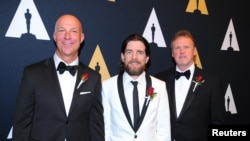An inflatable green screen more than seven meters high and optical device to simulate shaking are just two of the innovations that make the work of moviemakers easier and render movie effects more convincing. The developers of both innovations were among the honorees at this year's Sci-Tech Awards, presented Feb. 13 by the Academy of Motion Picture Arts and Sciences.
The Academy is better known for its Oscars, which will be presented in Hollywood February 28.
Michael Kirilenko of Vancouver, Canada, is one of four key grips, or supervisory rigging technicians, who came to Beverly Hills to receive a technical achievement award for the inflatable green screen, which is widely used in the industry. It is easy to move and lets directors blend live action and animation.
“Its first film was Godzilla,” said Kirilenko. “And from there, it did Tomorrowland. Right now, it's doing Planet of the Apes. It did X-Men. Avengers.”
For visual effects artist Brian McLean, a science project at age 11 led to career in stop-motion animation, which uses tiny figurines shot with incremental changes to trick the eye into seeing motion.
“It's basically the fact that your eye continues to see an object for a split second after that object disappears,” McLean explained.
McLean was honored with colleague Martin Meunier for a 3-D printing process that creates tens of thousands of characters, replacing hand-sculpted figurines. The system is used in productions from Oregon-based LAICA studios, starting with its 2009 animated film Coraline.
Michael John Keesling received a technical achievement award for a device that simulates shaking, for example, of a moving car or a violent earthquake.
“I was shown how it was normally done,” he recalled, “with an electric drill attached to the camera ...It would bump into the operator's eye.It would hurt the camera.And so I thought, well, what if you just shook the image?”
Keesling’s system, used in the 1998 film Saving Private Ryan and many movies since then, employs optical gel and a computer controller to achieve more realistic shaking.
Keesling says this Academy honor means a lot. “This is kind of like my college degree,” he said. “I was self-taught.I barely made it through high school, so this is like, I did it. I made it.”
Christoph Bregler and his colleague Ronald Mallet of the animation company Industrial Light & Magic were honored for a motion tracking system that transfers an actor's movements to an animated character.
Bregler says the system was welcomed by actors, who “don't have to wear these motion capture pajamas any more,” and directors and cinematographers, who “don't have to calibrate, like, 16 cameras. Anywhere you are ... on a boat, or if you're on a bridge or anything, you just need one camera to shoot it, and we can capture every pixel – every little pimple, every little eye blink, hair, anything.”
Jack Greasley was one of four honorees for MARI 3D software, whose name comes from the Swahili word for “beautiful,” maridadi.
The digital painting system was used in the 2009 fantasy Avatar and many films since then to increase their realism.
“When you're making a movie with a space ship or a monster, somebody needs to go in there and paint all the prime surface detail, all the wrinkles, all the pores, all the scratches, the dirt, the blood, the dust,” said Greasley. He says the visual effects artist “goes in there with literally a digital paintbrush and pore by pore, wrinkle by wrinkle, paints that in.”
For Hollywood actors, computer-generated effects make performances convincing, said Olivia Munn, who has a role in the upcoming X-Men: Apocalypse. She cohosted this year’s Sci-Tech award ceremony with actor Jason Segel.
She is impressed with the engineers who work behind the scenes to create digital characters and effects that seem realistic.“ They’ve made it possible for actors to not look so silly when we're out there screaming at something or fighting something.”
She says the film technology that helps make movie magic gets better every year.









